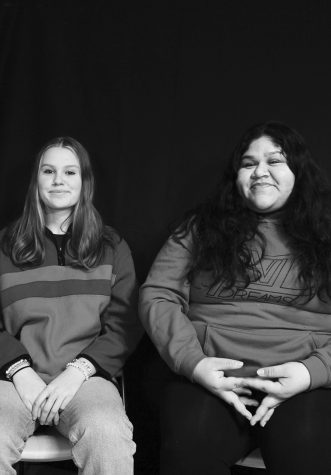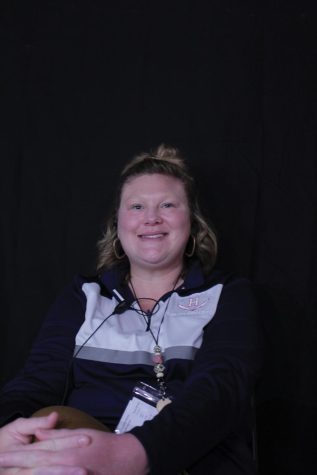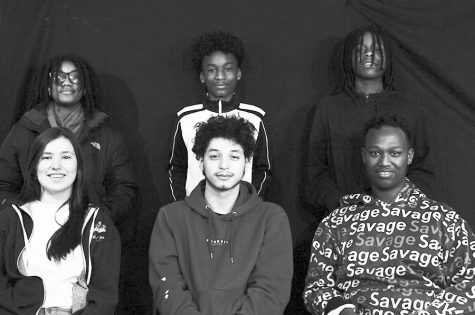What’s all the beef about?
February 6, 2023
Dr. Hensley speaks to impact of physical violence between students on administration, student body, learning environment
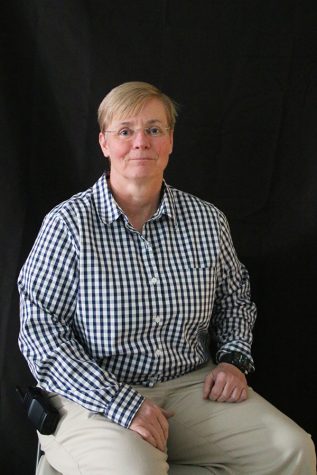
Dr. Melissa Hensley has been a school administrator for 18 years and a principal for all but two of those years. Over the course of her career, she has learned the common practices used in high schools in relation to student disagreements and altercations, as well as the challenges that come along with these practices.
Arriving at the semester mark of the 2022-23 school year, there have been a total of 10 physical fights in school. According to Hensley, this number is smaller than in past years.
“Six, seven, eight years ago, the data looks much different. The number of fights is coming down. Last year we had less than 20 fights, I think it was around 14 the entire year. That’s everything, considering [if you compare] a pretty heated [verbal] dispute to a [physical] dispute,” Hensley said.
Comparing these numbers to other schools in our area is difficult as Harrisonburg High School is overcrowded, holding 1,966 students, compared to surrounding high schools such as Spotswood High School with around 936 students and Turner Ashby High School with around 1,014 students. The middle schools in the area, Skyline Middle School and Thomas Harrison Middle School, both hold around 705 students. Hensley believes this unavoidable close contact between students during passing periods can spark feelings of anxiety that may lead to physical altercations.
“We’re at a different level, our school is very overcrowded. The middle schools have far fewer students in them. The majority of our fights happen [during] second breakfast which is the largest population that we have in the commons area. You’ve got students coming out of the gym, all of the outside coming in and most of the upstairs and the rest of the building coming towards that area either to go to class, to get breakfast or to find friends and socialize,” Hensley said. “For some students, the overcrowding creates a sense of anxiety and I think puts some students on edge than what we would see if we didn’t have so many people compacted together. I think it’s pretty hard for some to navigate [and] they become on the defensive quicker,” Hensley said.
Administration and counseling work together to find the best solution for both verbal and physical disagreements. The school offers mediation and restorative practices to get to the root of the problem or can also put in place a stricter solution such as disciplinary practices or a no-contact order.
“I don’t believe in violence as a means to resolving any conflict that students have. There’s disciplinary consequences, we also do restorative practices when it’s appropriate too. We have been doing a lot of preventative stuff too to try to get in front of disagreements. [We try to] resolve them in some way either through conferences with admin [or] working with school counselors. A lot of times if we get the students together, they’re able to talk it out and we’re able to resolve it. A lot of what we see is community based, where disagreements have spilled over into the school. We do a lot of things like separating kids who have had ongoing disagreements with one another where we have not been successful with restorative practices. We try to make sure they’re not in classes together [or] put no-contact orders in place to try to ensure that it’s not going to happen again,” Hensley said.
Both administration and teachers must be trained in how to handle these situations to the best of their ability. Faculty and staff are taught Mandt training when they are hired to put in place when needed. The strategies are not directed at teaching faculty and staff how to separate fights, but more so how to de-escalate a situation full of high emotions through verbal means.
“Mandt training focuses on utilizing verbal skills to de-escalate and recognize people that are in the crisis cycle. When you enter that crisis cycle, we have a baseline where we normally operate at. Anything thereafter starts through the crisis cycle where you reach a climax and then you eventually start to come back down and go through various phases. Each one of those phases, we are trained in what to do to best help a student at that level of crisis. Mandt training [also includes] guided assist strategies and a component on how to separate fights. It’s a little unrealistic, the way that they train it versus what we see, but we can manipulate some of those skills to guide people away from situations. There’s also a timer to that, so as soon as there is a Mandt hold being used, we’re timing it because at three minutes we have to let go. This training has some definite advantages to it, I like the verbal component,” Hensley said.
Going into her career as a school administrator, Hensley was aware of the variety of challenges she would face on a day to day basis, however shifting between different high school environments has been a change of pace.
“I wasn’t naive to what to expect in this role, but I would say you don’t know what you’re getting into until you really walk in this position. It’s also different from school to school in terms of what the themes are that you see that need to be addressed and that you didn’t anticipate. I think these things are always going to exist. I came here from Shenandoah County, very different clientele here, very different yet [the] same in terms of some of the needs,” Hensley said.
Hensley recognizes the emotional aspect that may affect the student body who have witnessed fights between their peers.
There’s no penalty for asking for help and resolving conflicts. We’re looking for how we can resolve this issue.
— Principal Dr. Melissa Hensley
“Because of the nature of those fights, it probably causes more anxiety for a lot of students because they are so heated. It takes multiple adults to get those kids separated and there’s usually a lot of high emotions. I would think that that would make it a very uneasy situation for a lot of other people that are here,” Hensley said.
Despite such high emotions, administration asks students to refrain from crowding or taking videos to ensure the safety of all students.
“It would help for safety purposes if students would back away and not be taking videos [or] getting in those clusters around them. There are times when we have a very difficult time getting to the center to separate it. I know when things happen, the natural response of most humans is to look into what’s going on. Most people are also looking to see if there is something they can do to help the situation. Ultimately, it’s a draw of attention, I don’t think most of the students are trying to put themselves in a position where they themselves could get hurt. I think it’s the curiosity of what’s going on. The ultimate goal is for everybody to be safe and healthy here. I get it, we see something, we’re certainly going to look, the dangerous piece really becomes when we get in those tight groups and we have a harder time getting to the center of that,” Hensley said. “I also don’t know that posting somebody else’s conflict on social media is in the best interest of anyone. I think that that has a lot of harmful ramifications. It perpetuates other situations occurring sometimes. I think it puts out a perception of our school that’s not accurate. I don’t feel like we have more fights than any other traditional high school of this size,” Hensley said.
Despite what some students may expect, asking for help before a conflict occurs will not result in consequences.
“[Consequences] are not the goal. From there, we talk about what can we do at this point? What’s the conflict? Is admin going to be the right person to try to mediate? Are we interested in mediation, restorative practices [or] any of the other services that we have? We’ve got a variety of things we can do If students would come and let us know. There’s no consequence [for that]. I ultimately don’t think students really want to be in those situations,” Hensley said. “We do get students who come to a school counselor and say ‘I’m having this conflict, I’m really concerned about this person potentially trying to do something to me.’ That’s very helpful because we can then intervene on the front end of that and have conversations before anything happens. There’s no penalty for asking for help and resolving conflicts. We’re not giving out a consequence because you came to us and said ‘I think I’m going to get in a fight.’ We’re looking for how we can resolve this issue so that nobody gets a consequence out of it.”
Cullip shares anxieties about school fights as high school teacher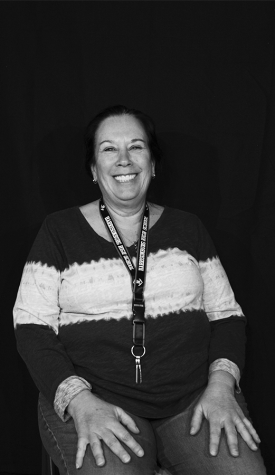
Computer science teacher Lorinda Cullip is a first year teacher and has experienced the realities of the high school environment up close throughout her first semester.
“I came here with no training other than knowing the background material. I thought, ‘I had six kids, I can do this, it can’t be that hard,’ but let me tell you, it’s the hardest job I’ve ever had in my life,” Cullip said.
Cullip experienced her first school fight one afternoon when walking down to the lunchroom. She was disturbed by the student reactions to the commotion.
“All of a sudden I saw all these students wanting to go over there. I was really surprised. They seemed excited, like they were witnessing some sporting event which was really bizarre. They had their phones and they were trying to video. I was really shocked and disturbed that instead of being afraid because someone was getting hurt, they were almost encouraging. It made me sick to my stomach to be honest,” Cullip said.
Experiencing this early in her teaching career frightened Cullip as she felt unprepared in knowing how to help students. This experience has taken a mental toll on her, recounting a nightmare she had that night.
“As an employee of the school system, my job is to teach and protect, to nurture and care for these students, I couldn’t do anything, I was so afraid. I didn’t know what to do. I felt like I was not trained to know what to do. I’m sure that there was some kind of online training that I have gone through, but to tell you the truth, it’s so overwhelming as a first year teacher that in the moment, I was paralyzed,” Cullip said. “I was glad to see that others knew what to do. Administrators came, the SRO came and they took care of the situation, but it really, really shook me up.”
Cullip’s daughter, Megan Cullip, is a biology teacher here as well. After witnessing this altercation, Cullip went to her daughter’s classroom for support.
“She recognizes that [fights] happen and she said that [they’ve been] happening more. I don’t want to say she thinks it’s normal, [but] I guess she is more used to it than I am because she’s been here a few years,” Cullip said.
Similarly, she was surprised to learn the high school requires two school resource officers (SRO’s).
“I know that we have resource officers here and just the fact that we need that is crazy in my mind. I went to high school 40 plus years ago. We didn’t have that. I could not imagine having to deal with this kind of stuff on a daily basis, being a resource officer or being an administrator that knows how to handle that or has to pull people apart,” Cullip said.
Cullip is frightened for her grandchildren who are already in middle school and will soon enter the high school environment with the possibility of being exposed to these events. She names overcrowding as a possible source of the problem.
“It terrifies me that they could be exposed to stuff like this in just a few years. As a parent, it’s terrifying. Is the ratio between administrators and teachers and students too high? If we’re over capacity, we shouldn’t be allowed to go over capacity. I don’t feel safe,” Cullip said.
How did we get to a point in society where we’re okay watching someone hurt someone else?
— Computer science teacher Lorinda Cullip
Cullip believes to continue to get young adults excited about becoming teachers, something must be done to put an end to these events.
“I’m brand new to this on the outside, but still, I’m not a young teacher just out of college that hasn’t seen the world. I’ve seen the world. I have a lot of life experiences and there’s some things that just aren’t right. If we’re going to attract teachers and attract talent, there’s a lot in my mind that needs to change,” Cullip said.
More than anything, Cullip questions not just the high school environment, but also society when it comes to how they react to violence. She firmly believes it’s time for a change.
“It makes me very scared for my daughter who works here, for myself, for the other teachers and it really turns my stomach that the students find this not only routine, but exciting,” Cullip said. “How did we get to a point in society where we’re okay watching someone hurt someone else? That’s just so incredibly sad.”
SRO’s Terrell, Bowers speak to job description abilities, keeping school safe
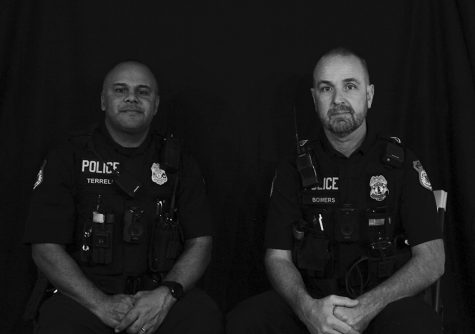 Walking into the school cafeteria, it’s hard not to notice the two police officers in full uniform: wearing tactical vests, with handcuffs and a sidearm, keeping watch over the students in that area. These police officers are better known as school resource officers (SRO’s) and their job is to keep students safe during the school day.
Walking into the school cafeteria, it’s hard not to notice the two police officers in full uniform: wearing tactical vests, with handcuffs and a sidearm, keeping watch over the students in that area. These police officers are better known as school resource officers (SRO’s) and their job is to keep students safe during the school day.
According to the Virginia Department of Criminal Justice Services, “A school resource officer is a certified law enforcement officer hired by the local law enforcement agency to provide law enforcement and security services to Virginia public elementary and secondary schools. They are assigned by the law enforcement agency to work in one or more schools, but remain under the administrative control of the law enforcement agency.”
SRO’s Ronnie Bowers and new addition, Chris Terrell ensure that all aspects of HHS are operating in a safe and secure fashion. Both officers previously worked with the Harrisonburg Police Department before taking a demotion to work in the high school.
“I’ve been a police officer for 25 years, through that time I’ve been a road officer, bike officer, investigator and most recently I was a supervisor. I actually took a demotion to come to work here at the school because I just wanted to make a difference in kids’ lives,” Terrell said.
While Terrell has just recently come to the school, Bowers has been the high school’s SRO for over five years.
“I volunteered to come to HHS, as crazy as that sounds, but my reasoning for coming here was because I worked the night shift most of my career as a patrol unit out on the streets just answering daily routine calls and I wanted the day shift spot. This was the only spot open. Once I got here and started doing the job, I really enjoyed it,” Bowers said.
When a fight occurs in school, one of the main concerns SRO’s consider is the overcrowding and likeliness it may result in a bigger issue. When the current school building opened in 2005, it was designed to accommodate 1,350 students, yet it currently holds 1,966 students.
“First and foremost [we are focused on maintaining] safety. When two students are fighting, I’m absolutely going to step in to try to keep them from harming each other, or other people because it’s very crowded. That’s my number one role, it’s not to arrest them or discipline them, [but] rather to keep people safe,” Bowers said. “For the most part, the administration typically handles that, but again, I’m not going to stand back and let someone get hurt.”
According to the Legal Aid Justice Center, “while stationed in schools, SROs have full police authority over students and staff. This means they can stop, question, charge, arrest, use chemical and mechanical restraints, and use other police practices on students and staff. SRO’s should not be involved in school discipline matters.”
Even though SRO’s have these abilities, things that aren’t putting groups of students in immediate danger, such as vaping, is left up to administration to deal with as a “disciplinary matter.”
“The school and the police department have what we call a MOU, a Memorandum of Understanding, which is a contract between the schools and the police that says ‘Hey this is what you guys can do and this is what we don’t want you to do.’ Probably the biggest difference is if there’s an emergency compared to a nonemergency,” Bowers said. “If there’s a fight, we try to break it up, if anyone would ever try to do any harm to the school, we will obviously try to step in and intervene. [However], when it comes to minor things, say vaping, which is illegal under the age of 21, we stay back and let the school handle it. Out on the street it’s different, if you saw someone who was 16 vaping, you could go deal with it and not think twice about it.”
Administration has certain training such as Mandt Training, where they are not allowed to hold onto a student for more than three minutes and can only use a Mandt hold (a specific hold so they don’t physically endanger the student) to separate a fight or altercation. Comparatively, SRO’s have no such restrictions.
“We’re not restricted as police officers. We are trained to do certain control moves that we practice. We will use the amount of force we need to control the student, we’re not going to immediately just use [excessive force] where it’s not needed,” Bowers said. “We’re not limited as to how long [we restrain a student] and what we can do to break up a fight.”
According to an article from Vox, “The key to understanding use-of-force policies is that, for the most part, they’re not designed to set limits on police. Instead, they’re designed as a way to guide police toward using appropriate types of force — which includes everything from verbal commands to lethal weapons.”
SRO’s go through training just like any other police officer. It helps them to know how exactly to restrain someone if it is needed to keep everyone safe.
“We go through ‘use of force training.’ You learn a lot of it in [the] basic police academy and then once you leave there, your department once a year, will expand on that. Sometimes literally just talking to people, we will consider the use of force, to know what to say and how to say it to try and talk people down. That’s our number one main goal, but sometimes, that’s not an option,” Bowers said. “[Beyond that], we’re taught to use physical restraints, by manipulating hands and fingers and arms or pressure points where the nerves are, to control that person. Then it can go from there. You can step it up, depending on their resistance. We do a lot of physical training, we don’t just watch a video. We physically grab hold of each other as police officers so we know what it feels like, how it works and how it doesn’t work.”
Beyond just working with students physically, Bowers and Terrell also work with the counselors and parents.
“I work with the counselors a lot, some of the students will come with problems at home or issues in their personal life, so we work with them. We’re not counselors, but we’re very informal counselors, so we deal with that a lot,” Bowers said. “We have parents that will come and ask questions, like what to do when their kids are acting up at home, so we do a lot behind the scenes. We really do.”
Even though the job involves risks, Terrell and Bowers enjoy their interactions with students each day more than anything else.
“I’ve always been a talker and I like to make people smile, so I try to make sure as many kids as I can talk to here have a better day,” Terrell said.
What happens after fight: students speak about what it means to be on other side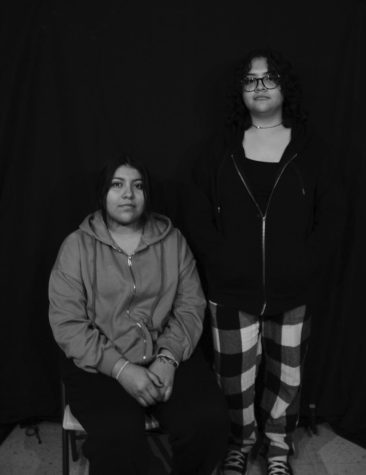
“Fights give people something to talk about,” sophomore Natnael Weldu said.
Music was blasting through Senior Kim Sanchez-Zarate’s earbuds while she walked through the halls. She had just finished her first block and was on the way to her second block. Her eyes were glued to her phone. She was scrolling through Instagram when she found a video of herself walking into a fight. The fight had broken out a couple feet away from her, she hadn’t noticed at the time, only while scrolling through Instagram later did she come upon the video.
“[I didn’t notice] the fight that started right [beside] me because I just kept walking [through] blasting my music. Then later I saw the fight on Instagram. It was like 38 seconds ago and I was like ‘what I was literally just right there,’” Sanchez-Zarate said.
Students often, after a school fight, see it posted on different platforms of social media.
“I usually see them through Instagram or Snapchat. Sometimes I like watching it, sometimes it’s just confusing,” Sanchez-Zarate said.
Seeing fights on social media is not a rare student occurrence. In fact, accounts across all platforms have been dedicated to just posting about HHS fights.
“I remember there used to be one account that posted about every fight that happened, but it got banned [through Instagram guidelines],” Sanchez-Zarate said.
These videos are shared and reposted frequently. Students like sophomores Yulliana Ayala and Natnael Weldu have first-hand experience with fights on social media. They both acknowledge how fast fight videos spread.
“It spreads around and I get it from others who are spreading it around,” Ayala said.
Weldu sees more fights on some platforms over others.
“I see the most fights on Snapchat because a lot of people post them on their stories. A lot of people view and share those fight stories. Sometimes I know the person, sometimes I don’t know the person,” Weldu said.
Ayala and Weldu both noted that when a fight starts, students gather around and become much more lively.
“It’s not that I like violence, it’s just [I like] to see who is fighting and who is going to win. I like to find out why someone is fighting [and] to see if it’s a stupid reason or if it’s actually a good reason for the fight,” Ayala said.
Weldu agreed with her statement.
“Everyone reposts it and everyone shares it around because they want to show their friends,” Weldu said.
Sophomore Christan Rashad Settles was in a fight with another student when bystanders started recording him.
“After the fight I left everything at the school, my backpack and my phone. I didn’t come back until later for my phone and it was blowing up, everyone was texting me,” Rashad Settles said.
He saw himself in the video and so did 500 other people. Looking back, Rashad Settles feels negatively about the situation after seeing it on Instagram.
“I saw myself on Instagram and I was disappointed in myself. I feel like I could have taken that situation and dealt with it way differently,” Rashad Settles said.
According to Rashad Settles, many individuals judged him after they saw the video.
“The truth is I’m not a bad person, but people and teachers judge me based on this one clip. It happens all the time to me. I understand why they would judge me based on that video, but we’re all humans and have bad reactions to things,” Rashad Settles said.
He expected students to record the fight he was involved in. He views this student behavior as normal, despite how it made him feel.
“I expected people to record me when we fought. Most kids my age when something unexpected happens they start recording,” Rashad Settles said.
While school fights have been happening for as long as most students can remember, the heightened use of social media and spreading videos has only recently become a popular thing. Students may see violence as entertainment and overlook the psychological impact of fights. Doctor Lora Cantwell, the former school psychologist, describes this as desensitization.
“[Younger generations] have access to everything, so they get desensitized. If something is seen 10 times and [you] see it again [you’re] not going to react to it anymore. There is a different reaction for the younger generation to violence and aggression,” Cantwell said.
Cantwell further explains the differences between generations when it comes to fights in school.
“When I was growing up, it just didn’t happen [like it is now]. There wasn’t a lot of planning. It was spontaneous. Whereas now it’s, you get people involved, and there’s a lot of chatter beforehand. There’s a lot of energy going into it. I’ve heard stories of people taking Ubers to a fight. It’s crazy to see technology used in that way, ”Cantwell said.
Cantwell emphasizes the difference of fight culture between generations.
“When we were growing up and [fights] happened, we got a break from it, we went home and our system got a chance to recover,” Cantwell said.
The opposite happens for the younger generation. Fights do not stop when students stop fighting, but it continues further through the use of technology.
“For [students now] it doesn’t stop. You leave [school] and you’re dealing with it around the clock because people are posting [about the fights],” Cantwell said.
Fighting can interrupt school day, learning environment
“Most of the time I think fights are started by two people beefing over something. Sometimes it might be over a girl or a guy, or they will just get into an argument and then just start fighting. I do think some people just like fighting, so I feel like some people fight in our school just because,” Spears said.
A lot of the time the cause of the fight between students is unknown to the onlookers. The fight could have been provoked by something outside of school, days before.
“Most of the time I don’t actually know what they are fighting about, but sometimes I just see it as two people getting mad so they fight. I think a lot of times it can be a little petty,” Spears said. “It is a simple conversation that can happen, but instead they just fight. I don’t think it solves anything if you fight someone, you are just going to get more mad at them. The issue before the fight is still there because you didn’t talk about it, so you couldn’t solve anything. I don’t really think it is even a way to solve problems.” It is a simple conversation that can happen, but instead they just fight. I don’t think it solves anything if you fight someone, you are just going to get more mad at them. The issue before the fight is still there because you didn’t talk about it, so you couldn’t solve anything. I don’t really think it is even a way to solve problems. — Shea Spears
Spears has seen enough fights that she believes it does pose an issue. It can cause a distraction from learning as well as cause a disruption to everything around it.
“I think fights at this school start to turn into an issue because they end up happening very often. I feel like we have had times where there have been more than one fight in a day. That turns into an issue because it can interrupt class,” Spears said. “I also feel like teachers and officers don’t seem to respond well. They just let it happen and that seems wrong.”
Junior Kaylee Torres has seen a few fights in her three years going to Harrisonburg High School.
“I always see them during lunch. If there is a fight it’s happening during lunch,” Torres said.
Spears sees fights happen without administration or the school resource officers (SRO’s) responding quickly. This leaves Spears to question if it is because they don’t see the fight, don’t know what to do, or because they have certain protocols that are unknown to students, making it appear that they are not responding.
“Sometimes I will see two students arguing and it is getting really heated and teachers sometimes break it up. They will just be like ‘alright you need to stop.’ You can really tell there is about to be a fight and the teachers don’t do anything to separate the kids initially. Then they start fighting and I don’t know if there is much that teachers know how to do, so they just stand in between it. They don’t seem to really know how to respond when people fight,” Spears said.
Spears also believes that overcrowding has an impact on school fights.
“Our school is also obviously very overcrowded which I would assume doesn’t help when a fight happens. Everyone around rushes to [see] it. I have watched fights and I have run up to see what is going on because they can be exciting. Because everyone is all crammed into the same area, the SRO’s don’t appear to break up the fights for a while,” Spears said.
When fights happen students crowd to watch. Taking up space and time that students generally use to get to class.
“Because I always see them in the cafeteria, everyone rushes over to see what’s going on. And it fills the whole area making it hard to get to my next class,” Torres said.
Assistant Principals Burner, Johnston safety of students is number one priority
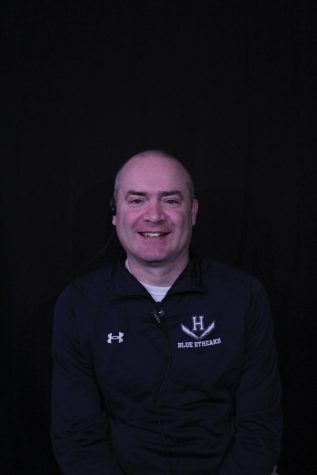 “One of our main jobs and a job that keeps us busy is just making sure that we keep all students safe. That’s the main job of any adult in the building. We’re in charge of 2000 kids, keeping them all safe. So that’s number one priority,” Burner said.
“One of our main jobs and a job that keeps us busy is just making sure that we keep all students safe. That’s the main job of any adult in the building. We’re in charge of 2000 kids, keeping them all safe. So that’s number one priority,” Burner said.
Assistant Principal Jennifer Burner has taught at the high school for three years now. As an assistant principal one of her jobs is to handle any physical altercations that happen. Burner describes the main priority during this time is all of the students’ safety.
“Any time there is any type of situation, [I] just automatically clear [my] brain above all else and [say] ‘okay, I have to keep this student safe,’” Burner said.
While thinking about students safety, the administration has to take into account the overcrowding in the high school. The school has close to 2,000 students in a structure built for 1,350. Whether or not that contributes to the number of fights in school is something to consider.
“Honestly, even if you have a school of 500 [kids] they’re dealing with the same issues [as us]. We are just on a bigger scale than others. [It’s more [of] a social problem,” Burner said.
Before coming here Burner taught at Central High School in Shenandoah County. Central has about 730 students, moving to a bigger school also came with a higher position, as an assistant principal instead of a teacher, and more kids to keep safe.
“Anytime you add more kids it makes it harder. If we had 500 kids, then it would be a lot, but together the staff and admin work together to make sure kids are in class and not skipping where they’re supposed to be because that’s what keeps you safe,” Burner said.
Along with overcrowding, social media is another large shift in communication that may have contributed to some of the physical altercations in schools.
“I taught for 14 years before I came to HHS, and there has just been a huge paradigm shift with social media. A lot of disagreements stem from social media.” Burner said. “Social media has made things difficult, because you can talk to anybody at any time. Whereas when I was in high school, at the end of the day, unless somebody called you on your house phone, it was done.”
Another assistant principal Heath Johnston also transferred from Central. Johnston transferred to HHS after working at Central High School with Dr. Melissa Hensley for about six years. He also had to get used to the larger population of students. Johnston along with all of the other assistant principals had to learn tactics to handle physical altercations that break out in schools.
“[The school system] train[s] us in mandt which is different ways to try to a prevent fights getting in between it [and] more de-escalation stuff. Or, like a lot of times, I see students having conflict, get in between I’m trying to remove them from the situation, things like that sometimes for school safety,” Johnston said.
Mandt is a training program many schools have adopted across the U.S. as a way of de-escalating a situation when it has the potential to get violent. The Mandt System is a training process staff members go through to ensure a safe environment in the school, and is taught to all staff. The main responsibility and priority is to keep all the students and staff safe in the school.
“The main thing [I think about is] I don’t want somebody to get hurt. It’s our job to prevent things from escalating, but from time to time, there is a fight, [our job is] to keep people safe, so we want to get in between it,” Johnston said.
Unlike Burner, Johnston doesn’t contribute a lot of the violence in school to overcrowding.
“From being at this school and other schools, if there’s a fight [it’s going to] happen for different reasons, sometimes it’s because somebody bumped into somebody and they won’t even know each other. A lot of times it may be something that happened out in the community and it’s tempting to run into each other at school. So, I mean, I don’t think it’s the overcrowding,” Johnston said. “Sometimes [the fights happen for] no reason at all, but I think considering the size of the group of students here, I don’t know what it was like before I got here, but I think the kids here get along pretty well. There’s gonna be a fight from time to time in any school.”
Administrators find students sometimes aren’t the most helpful when a fight breaks out. Students crowd around fights to watch making the admins job more difficult. Admin spread out throughout the school to make sure that if an altercation were to happen, they would be able to get to the scene as quickly as possible.
“We try to do a good job of spreading out and having people around everywhere at the school so that’s part of the safety thing. I mean, the more teachers and administrators that are visible between classes that are in the halls, it’s a big, a big help as far as behaviors. I mean, you’re less likely, if there are two teachers standing there or administrators standing there, to do something,” Johnston said.
Fights prove to endanger students during school hours
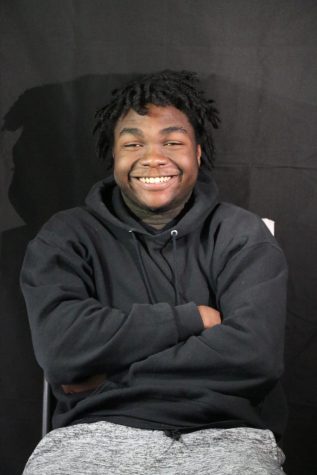 Thinking of school, the first thing that comes to mind shouldn’t be violence. Unfortunately, that’s the case in many circumstances. In the 2020-2021 school year, 11.0% of incidents in Virginia high schools have regarded fighting and conflict. This school year alone, there have been 10 fights. Many students at Harrisonburg High School are the initiators of the fights while another population of students decide to stay back and refrain from getting involved. Senior Nemah Ibrahim finds fights to be unnecessary unless there’s a valid reason.
Thinking of school, the first thing that comes to mind shouldn’t be violence. Unfortunately, that’s the case in many circumstances. In the 2020-2021 school year, 11.0% of incidents in Virginia high schools have regarded fighting and conflict. This school year alone, there have been 10 fights. Many students at Harrisonburg High School are the initiators of the fights while another population of students decide to stay back and refrain from getting involved. Senior Nemah Ibrahim finds fights to be unnecessary unless there’s a valid reason.
“I find [fights] pointless in some ways. I would understand if it were to happen for specific reasons with people, but I don’t really care about them in ways where I just walk past it when it happens. I’ll obviously look over to see it because it is entertaining, but most of the time I try not to pay attention to it because it’s unnecessary,” Ibrahim said.
For sophomore James Davis, the sporadic brawls that have occurred during school days are also unnecessary.
“I don’t care much about it since I’m mostly never there to see them, but it happens way too frequently. There’s nothing we can do about it since they happen in random places. People will be in the wrong place [at the] wrong time. It happens when two people just don’t like each other,” Davis said.
To Ibrahim, fights should be done elsewhere and not on school grounds.
“If you were to fight someone, you shouldn’t do it at school. You should just do it somewhere else,” Ibrahim said.
Davis believes that fights are a result of disagreements and should be kept to a minimum.
“If you asked me this question in middle school, I’d probably say yes [fights are necessary], but now I don’t care, so probably not. It’s better to keep to yourself instead of fighting for dumb reasons. There’s no reason for you to be fighting for getting pushed, just leave it alone,” Davis said.
Similar to Ibrahim, sophomore Yariliz Pacheco believes that school is the wrong place for fights because of the number of students.
“I feel like school is not the best place to have a fight because there are a lot of students, but I feel like a lot of people are entertained by the fights,” Pacheco said.
Some students don’t often pitch in to help out with breaking up fights, so they can avoid getting caught up in the middle of it themselves.
“Some people just don’t want to get hit, some people wait for the teachers to come or people just like to record. I’d rather just sit there since it’s none of my business, that’s their business,” Davis said.
There isn’t always a reason for fights. Pacheco finds fights are a result of social pressure.
“I feel like a lot of people do antagonize people to start a fight, so I feel like sometimes people want to fight, [but] there’s other reasons people fight,” Pacheco said.
Students of HHS: are fights good, bad or somewhere in between?
This chant is heard across the lunchroom as students swarm to watch two others duel.
Many students take pleasure in watching the fights. Watching them and filming them is the highlight of freshman Maleak Jones’ days.
“I think the fights are very good. They’re very entertaining. Without fights I think many people wouldn’t come to school,” Jones said. “Today, [Dec. 8], there was a fight, it was very entertaining. I got a good laugh in and that really made my day.”
While Jones believes fights are entertaining, he doesn’t think they are smart. According to Jones, many fights are started over jealousy, relationship drama, food, video games or particularly the stealing of vapes.
“I think when people fight, it stops the bad people from doing bad things because then they get suspended and go home. The good people get to stay here,” Jones said.
Though Jones is only a freshman, he has witnessed a number of fights and participates in the encouragement of them. He particularly enjoys getting to film them.
“If the person that gets beat up talks a lot of trash towards you, you can post [the video] or send it to them and be like ‘this you?’,” Jones said.
Freshman Ny’saun Brown takes a similar stance on the issue.
“I’m not going to complain about fights, it’s entertaining, it’s nice. I think our school is going to be fine,” Brown said.
Brown has seen fights a number of times this semester already and continues to experience only positive thoughts towards them, despite believing they are started over superficial conflicts.
Sophomore Aron Medhin’s thoughts couldn’t be more different.
“I strongly disagree with [the statement that fights are good].[The students] get to come back to school and [fights] aren’t going to do anything,” Medhin said.
Junior Luis Arbaiza Lopez takes a more neutral stance on physical altercations in the school environment, but believes admin should do more to crack down.
“This year fights are fought over some dumb things. I really don’t mind them. People should just do what they want to do,” Arbaiza Lopez said. “I haven’t seen that many fights, but I think it’s entertaining. I don’t care about that kind of stuff.”
Junior Liyani Garcia Yates agrees that fights have occurred over immaturity more than any other year, but believes the transition with new classes coming are of particular cause.
“[Fights] are definitely not [the way to deal with problems]. Everything can be talked out like your family,” Garcia Yates said. “People are very immature and young adolescents are bound to butt heads. For some people, [fights are attention seeking].”
Though Garcia Yates believes fights are immature, she still finds them invigorating, and would find it hard to walk away from a fight.
“I feel as though teens growing up have many issues, especially issues within, to express those issues or any family issues, they take it out on other people, causing fights especially if they don’t know how to manage their emotions,” Garcia Yates said. “[One thing I would say to students that fight a lot] is walk away, calm down and come back to the issue.”
For junior Lydia Showalter, the number of fights at school has surprised her. Showalter also believes that there are much better ways to deal with conflict that arises.
“The culture of resorting to fighting to deal with conflict was surprising when I first came to HHS and I think it still is. I think there are better ways to deal with conflict,” Showalter said. “Having discussions with people [can be helpful], but not just with the person that you’re mad at. Having another person there, an adult or another unbiased perspective [is the best way to deal with conflicts].”
While Showalter was at first shocked by the fights, they are no longer too much of a concern to her.
“I think [fights] are an issue. I think we should have better strategies for dealing with conflict. I don’t think it’s as big of an issue as some of the other people I’ve talked to. I don’t think it’s healthy though,” Showalter said.
Garcia Yates and Showalter believe more facilitated conversations and emotional training or education would be most efficient in working to control the number of conflicts that turn into fights.
Parent, Hamner, express concern over physical altercation, student safety
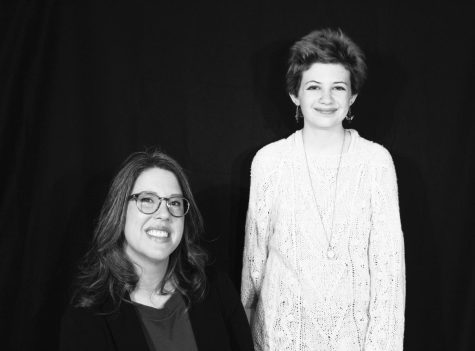 Bethany Hamner is the parent of a freshman. After moving from Texas, her experience with the HCPS school system has been nothing but positive. However, her child recently alerted her to physical altercations that happen during the day.
Bethany Hamner is the parent of a freshman. After moving from Texas, her experience with the HCPS school system has been nothing but positive. However, her child recently alerted her to physical altercations that happen during the day.“I was a bit surprised [when I first heard about the fights at HHS]. Our experience with the Harrisonburg City Schools has been very positive. Across campuses, we have found policies, personnel and students to be welcoming and inclusive. Physical altercations between students present real challenges for ensuring HHS is a place where all students can learn and thrive,” Hamner said.
While Hamner believes the fights to be of concern, her child has expressed that fights are not difficult to avoid during the day.
“I am not nervous to send my child to school. They do not report seeing or hearing about fights daily and they indicate it isn’t hard to steer clear of fights. My concerns would be more pronounced if my child reported being directly affected by fights or individually targeted,” Hamner said.
Despite Hamner and her child not finding the conflict difficult to avoid, they do find it unsettling.
“Preventing forms of school violence requires preventative strategies that address the underlying causes of violence. Among these strategies are efforts to help students learn to manage conflict productively,” Hamner said. “These efforts can be supplemented by efforts to provide more supervision in times and places where fights are most likely to break out and disciplinary policies that signal the school’s commitment to ensuring a safe place for all students to learn.”
Hamner is not sure of current disciplinary policies or efforts to prevent violence in the school, but does believe the school needs to focus on making students feel safe.
“Preventing fighting is important to ensure schools remain safe places for all students to learn. As a parent, I am more concerned about forms of school violence, like bullying, that are less visible. They may not cause the same stir in the cafeteria, but they can be more isolating and damaging to targeted students,” Hamner said. “I think of fights as different than assaults or bullying, where one student is targeted by another. If a fight requires two willing participants, the solutions should focus on helping students learn other ways to manage strong emotions and resolve conflicts.”

